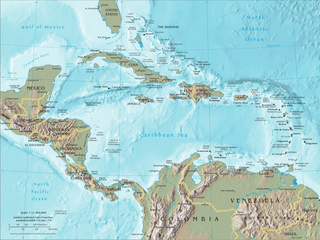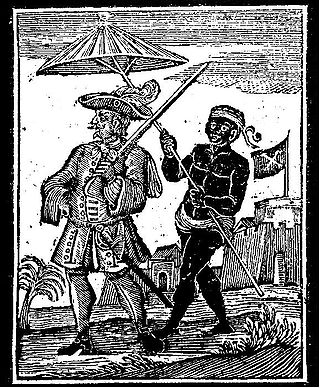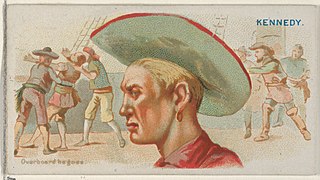Related Research Articles

The era of piracy in the Caribbean began in the 1500s and phased out in the 1830s after the navies of the nations of Western Europe and North America with colonies in the Caribbean began combating pirates. The period during which pirates were most successful was from the 1660s to 1730s. Piracy flourished in the Caribbean because of the existence of pirate seaports such as Port Royal in Jamaica, Tortuga in Haiti, and Nassau in the Bahamas. Piracy in the Caribbean was part of a larger historical phenomenon of piracy, as it existed close to major trade and exploration routes in almost all the five oceans.

Bartholomew Roberts, born John Roberts, was a Welsh pirate who was, measured by vessels captured, the most successful pirate of the Golden Age of Piracy. During his piratical career, he took over 470 prize ships. Roberts raided ships off the Americas and the West African coast between 1719 and 1722; he is also noted for creating his own Pirate Code, and adopting an early variant of the Skull and Crossbones flag.

John Rackham, commonly known as Calico Jack, was an English pirate captain operating in the Bahamas and in Cuba during the early 18th century. His nickname was derived from the calico clothing that he wore, while Jack is a nickname for "John".
Captain Benjamin Hornigold (1680–1719) was an English pirate who operated during the tail end of the Golden Age of Piracy.

Stede Bonnet was a Barbadian-born pirate and military officer, known as the Gentleman Pirate for the reason that he was a moderately wealthy landowner before turning to a life of crime. Bonnet was born into a wealthy English family on the island of Barbados, and inherited the family estate after his father's death in 1694. Despite his lack of sailing experience, Bonnet decided he should turn to piracy in the winter of 1716 or spring of 1717. He bought a sailing vessel, the Revenge, and travelled with his paid crew along the Eastern Seaboard of what is now the United States, capturing other vessels and burning other Barbadian ships.

Henry Every, also known as Henry Avery, sometimes erroneously given as Jack Avery or John Avery, was an English pirate who operated in the Atlantic and Indian oceans in the mid-1690s. He probably used several aliases throughout his career, including Benjamin Bridgeman, and was known as Long Ben to his crewmen and associates.

Edward "Ned" Low was a notorious pirate of English origin during the latter days of the Golden Age of Piracy, in the early 18th century. Low was born into poverty in Westminster, London, and was a thief from an early age. He moved to Boston, Massachusetts, as a young man. His wife died in childbirth in late 1719. Two years later, he became a pirate, operating off the coasts of New England and the Azores, and in the Caribbean.

A pirate code, pirate articles, or articles of agreement were a code of conduct for governing pirates. A group of sailors, on turning pirate, would draw up their own code or articles, which provided rules for discipline, division of stolen goods, and compensation for injured pirates. Breaking the code could get a pirate marooned or killed.
Henry Jennings was an 18th-century English privateer from the colony of Bermuda, who served primarily during the War of the Spanish Succession and later served as leader of the pirate haven or "republic" of New Providence.

Walter Kennedy was an English pirate who served as a crew member under Howell Davis and Bartholomew Roberts.
See also 1719 in piracy, 1721 in piracy and Timeline of piracy.
Caesar, later known as “Black Caesar”, was a West African pirate who operated during the Golden Age of Piracy. He served aboard the Queen Anne's Revenge of Edward Teach (Blackbeard) and was one of the surviving members of that crew following Blackbeard’s death at the hands of Lieutenant Robert Maynard in 1718. Myths surrounding his life - that he was African royalty and terrorized the Florida Keys for years before joining Blackbeard - have been intermixed with legends and fictional accounts as well as with other pirates.

John Phillips was an English pirate captain. He started his piratical career in 1721 under Thomas Anstis, and stole his own pirate vessel in 1723. He died in a surprise attack by his own prisoners. He is noted for the articles of his ship, the Revenge, one of only a few complete sets of pirate articles to survive from the so-called Golden Age of Piracy.

The capture of John "Calico Jack" Rackham was a single-ship action fought between English pirate Calico Jack and British privateer Jonathan Barnet. The battle was fought in the vicinity of Negril, Jamaica and ended with the capture of Rackham and his crew.

The Battle of Cape Lopez was fought in early 1722 during the Golden Age of Piracy. A Royal Navy ship of the line under the command of Captain Chaloner Ogle defeated the pirate ship of Bartholomew Roberts off the coast of Gabon, West Africa.

Piracy was a phenomenon that was not limited to the Caribbean region. Golden Age pirates roamed off the coast of North America, Africa and the Caribbean.
Saladin was a British barque that made voyages between Britain and the coast of Peru, carrying shipments of guano. The ship is best known for its demise in an act of mutiny, murder and piracy which began with the murder of its captain and officers and ended with the ship being stranded off the coast of Nova Scotia on 21 May 1844, followed by the last major piracy trial in Canada.

Philip Roche (1693–1723) was an Irish pirate active in the seas of northern Europe, best known for murdering the crews and captains of ships he and his men took over.
Captain Grinnaway was a pirate from Bermuda, best known for being briefly and indirectly involved with Edward Teach.
John Cole was a pirate active off the American eastern seaboard. His brief career is associated with Richard Worley and William Moody. He is known more for the unusual cargo of his pirate ship than for his piracy.
References
- 1 2 3 4 5 Marley, David (2010). Pirates of the Americas. Santa Barbara: ABC-CLIO. p. 96. ISBN 9781598842012 . Retrieved 13 June 2017.
- 1 2 3 4 An Impartial Hand (1675). The Grand pyrate, or, The life and death of Capt. George Cusack, the great sea-robber with an accompt of all his notorious robberies both at sea and land : together with his tryal, condemnation, and execution / taken by an impartial hand. London: Printed for Ionathan Edwin at the Sign of the Three Roses. Retrieved 13 June 2017.
- 1 2 3 4 5 W, R (1674). News from sea or, the takeing of the cruel pirate, being a full and true relation how Captain Cewsicke, alias Dixon, alias Smith, an Irish-Pyrate took an English ship of 500. Tuns culled the Saint Anne, laden with deals from Norway belonging to Captain Shorter, and putting 18. Men that they found aboard into a small boat without food, compass or tackling, barbarously exposed them to the mercy of the sea, where they must certainly have perisht, had not a Dutch ship by Gods providence taken them up, and set them on shore in Norfolk, as also how they carried the said ship into Aberdeen in Scotland, and borrowed 219. pound on her ladeing where she was soon after seized, and the said pirate, and 13. of his men since taken neer Lee, and brought up to the Marshalseas in South-warke, where they now remain prisoners. London. Retrieved 13 June 2017.
- ↑ "The Pirate Surgeon's Journal: Golden Age of Piracy History of Pirate Surgeons Page 6". www.piratesurgeon.com. Retrieved 13 June 2017.
- ↑ Brewer, Benjamin Heymann (2010). Every Kidd Has His Day: A Story of How Pirates Forced the English to Reevaluate Their Foreign Policy in the Indian Ocean (1690-1700) (BA thesis). Wesleyan University. doi: 10.14418/wes01.1.617 . Retrieved 13 March 2023.
- ↑ Fox, E. T. (2013). 'Piratical Schemes and Contracts': Pirate Articles and their Society, 1660-1730 (PDF). Exeter: University of Exeter. Retrieved 15 June 2017.
- ↑ Frohock, Richard (2007). "Bible Overboard: The Word and the Grand Pirate, Captain George Cusack". Early American Literature. 42 (2): 263–283. doi:10.1353/eal.2007.0018. S2CID 162393261.
